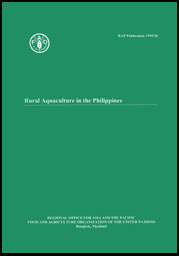
RAP Publication 1999/20

|
|
RAP Publication 1999/20 |
REGIONAL OFFICE FOR ASIA AND THE PACIFIC
FOOD AND AGRICULTURE ORGANIZATION OF HTE UNITED
NATIONS
Bangkok, Thailand
|
The designations employed and the presentation of material in
this publication do not imply the expression of any opinion whatsoever on thew
part of the Food and Agriculture Organization of the United Nation concerning
the legal status of any country, territory, city or area or of its authorities,
or concerning the delimitation of its frontiers or boundaries. Opinion expressed
in this publication are those of the author alone and do not imply any opinion
whatsoever on the part of FAO. |
2. OVERVIEW OF PHILIPPINE AQUACULTURE
3. ROLE OF AQUACULTURE IN DEVELOPMENT
4. SOCIO-ECONOMIC ASPECTS OF PHILIPPINE AQUACULTURE
4.1. The Freshwater Fishponds
4.2. Brackishwater Fishponds
4.3. Fishpens
4.4. Cage Culture
4.5. Seaweed Farming
4.6. Mussel and Oyster Farming
4.7. Rice-Fish Farming
6. NATIONAL PROGRAMMES FOR AQUACULTURE DEVELOPMENT
6.1. National Policies
6.2. Strategies and Plans
6.3. Programmes and Projects
8. OPPORTUNITIES FOR FURTHER DEVELOPMENT
8.1. Highlights of Past Development Projects
8.2. Current and Planned Projects with Aquaculture Component
8.3. Women in Aquaculture
9.1. A Redefinition of Rural Aquaculture Systems in the Philippine Context
9.2. Production Systems, Facilities, Species
10. RECOMMENDATIONS FOR RURAL AQUACULTURE PROJECTS
10.1. Rice and Fish Project
10.2. Mussel and Oyster Farming
10.3. Mangrove Pen Culture
10.4. Mariculture Park